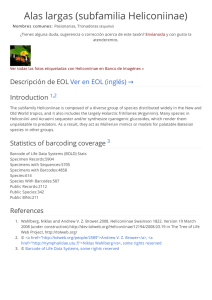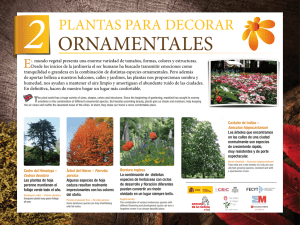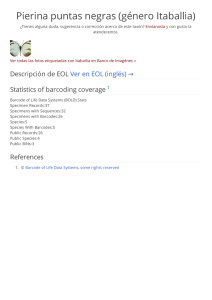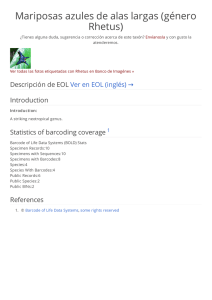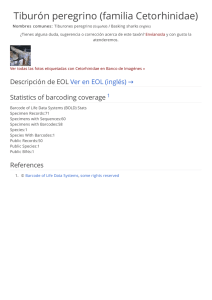Fish fauna from the Ajó river in Campos del Tuyú National Park
Anuncio
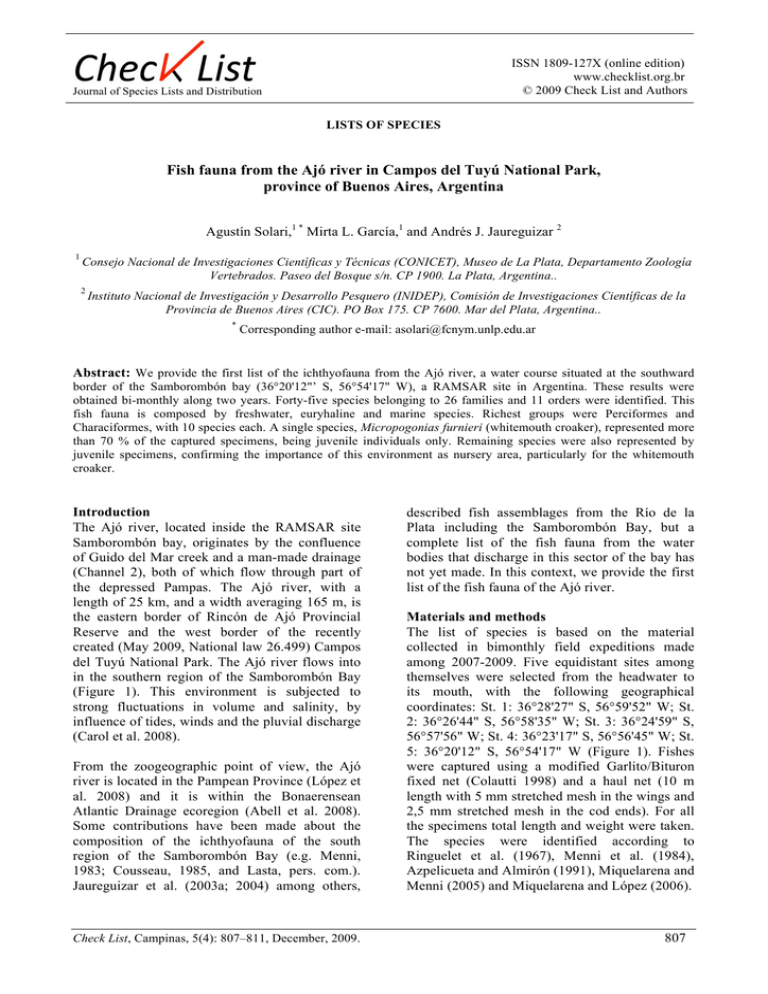
ISSN 1809-127X (online edition) www.checklist.org.br © 2009 Check List and Authors Journal of Species Lists and Distribution LISTS OF SPECIES Fish fauna from the Ajó river in Campos del Tuyú National Park, province of Buenos Aires, Argentina Agustín Solari,1 * Mirta L. García,1 and Andrés J. Jaureguizar 2 1 Consejo Nacional de Investigaciones Científicas y Técnicas (CONICET), Museo de La Plata, Departamento Zoología Vertebrados. Paseo del Bosque s/n. CP 1900. La Plata, Argentina.. 2 Instituto Nacional de Investigación y Desarrollo Pesquero (INIDEP), Comisión de Investigaciones Científicas de la Provincia de Buenos Aires (CIC). PO Box 175. CP 7600. Mar del Plata, Argentina.. * Corresponding author e-mail: asolari@fcnym.unlp.edu.ar Abstract: We provide the first list of the ichthyofauna from the Ajó river, a water course situated at the southward border of the Samborombón bay (36°20'12"’ S, 56°54'17" W), a RAMSAR site in Argentina. These results were obtained bi-monthly along two years. Forty-five species belonging to 26 families and 11 orders were identified. This fish fauna is composed by freshwater, euryhaline and marine species. Richest groups were Perciformes and Characiformes, with 10 species each. A single species, Micropogonias furnieri (whitemouth croaker), represented more than 70 % of the captured specimens, being juvenile individuals only. Remaining species were also represented by juvenile specimens, confirming the importance of this environment as nursery area, particularly for the whitemouth croaker. Introduction The Ajó river, located inside the RAMSAR site Samborombón bay, originates by the confluence of Guido del Mar creek and a man-made drainage (Channel 2), both of which flow through part of the depressed Pampas. The Ajó river, with a length of 25 km, and a width averaging 165 m, is the eastern border of Rincón de Ajó Provincial Reserve and the west border of the recently created (May 2009, National law 26.499) Campos del Tuyú National Park. The Ajó river flows into in the southern region of the Samborombón Bay (Figure 1). This environment is subjected to strong fluctuations in volume and salinity, by influence of tides, winds and the pluvial discharge (Carol et al. 2008). From the zoogeographic point of view, the Ajó river is located in the Pampean Province (López et al. 2008) and it is within the Bonaerensean Atlantic Drainage ecoregion (Abell et al. 2008). Some contributions have been made about the composition of the ichthyofauna of the south region of the Samborombón Bay (e.g. Menni, 1983; Cousseau, 1985, and Lasta, pers. com.). Jaureguizar et al. (2003a; 2004) among others, Check List, Campinas, 5(4): 807–811, December, 2009. described fish assemblages from the Río de la Plata including the Samborombón Bay, but a complete list of the fish fauna from the water bodies that discharge in this sector of the bay has not yet made. In this context, we provide the first list of the fish fauna of the Ajó river. Materials and methods The list of species is based on the material collected in bimonthly field expeditions made among 2007-2009. Five equidistant sites among themselves were selected from the headwater to its mouth, with the following geographical coordinates: St. 1: 36°28'27" S, 56°59'52" W; St. 2: 36°26'44" S, 56°58'35" W; St. 3: 36°24'59" S, 56°57'56" W; St. 4: 36°23'17" S, 56°56'45" W; St. 5: 36°20'12" S, 56°54'17" W (Figure 1). Fishes were captured using a modified Garlito/Bituron fixed net (Colautti 1998) and a haul net (10 m length with 5 mm stretched mesh in the wings and 2,5 mm stretched mesh in the cod ends). For all the specimens total length and weight were taken. The species were identified according to Ringuelet et al. (1967), Menni et al. (1984), Azpelicueta and Almirón (1991), Miquelarena and Menni (2005) and Miquelarena and López (2006). 807 Lists of Species Results and discussion Forty five species belonging to 26 families and 11 orders were identified. Characiformes and Perciformes were represented by 10 species each, followed by Siluriformes with 6 species, Clupeiformes with 5 species, Atheriniformes and Pleuronectiformes with 3 species, Cyprinodontiformes with 2 species and the remaining orders with only one each (Table 1). This usual conformation with an identical diversity in two groups, one characteristic of fresh water and the other mostly marine, clearly indicates the brackish conditions of the studied environment and the great variety of habitats available under estuarine conditions. One single species, Micropogonias furnieri, the whitemouth croaker, was the most abundant species (more of 70 %) followed by Odontesthes argentinensis (4.9 %), Brevoortia aurea (1.2 %), Paralonchurus brasiliensis (1.1 %); the remaining species did not reach 1 %. Micropogonias furnieri was found associated to coastal and estuarine waters, which are nursery and feeding areas of juveniles (Macchi et al. 1996; Acha et al. 1999; Jaureguizar et al. 2003b; Braverman et al. 2009). In the whole area of study, M. furnieri represented respectively the 70.2 % and 89.8 % of the biomass and number of individuals. The capture was totally composed by juveniles measuring around 80 mm total length, which confirms that the studied area functions as a nursery to a large number of species, many of them commercially exploited. Figure 1. Collection sites (black circles) in the Ajó river. ———————————————— Table 1. Ichthyofaunal composition of Ajó river, including the site of fish collected. List of collected species 1 2 3 4 5 x x x x x x x x x x x x x x x x Characiformes Characidae Oligosarcus jenynsii (Günther, 1864) Cheirodon interruptus (Jenyns, 1842) Astyanax eigenmanniorum (Cope, 1894) Astyanax sp. Bryconamericus iheringi (Boulenger, 1887) Hyphessobrycon anisitsi (Eigenmann, 1907) Hyphessobrycon togoi Miquelarena and Lopéz, 2006 Check List, Campinas, 5(4): 807–811, December, 2009. x x 808 Lists of Species List of collected species Curimatidae Cyphocharax spilotus (Vari, 1987) Cyphocharax voga (Hensel, 1870) Erythrinidae Hoplias malabaricus (Bloch, 1794) Siluriformes Callichthyidae Corydoras paleatus (Jennyns, 1842) Heptapteridae Pimelodella laticeps Eigenmann, 1917 Rhamdia quelen (Quoy and Gaimard, 1824) Loricariidae Loricariichthys anus (Valenciennes, 1835) Pimelodidae Parapimelodus valenciennis (Kröyer, 1874) Pimelodus albicans (Valenciennes, 1840) Cyprinodontiformes Anablepidae Jenynsia multidentata (Jenyns, 1842) Poeciliidae Cnesterodon decemmaculatus (Jenyns, 1842) Cypriniformes Cyprinidae Cyprinus carpio Linné, 1758 Atheriniformes Atherinidae Odontesthes argentinensis (Valenciennes, 1835) Odontesthes bonariensis (Valenciennes, 1835) Odontesthes sp. Clupeiformes Clupeidae Brevoortia aurea (Agassiz, 1829) Platanichthys platana (Regan, 1917) Ramnogaster arcuata (Jenyns, 1842) Engraulidae Anchoa marinii Hildebrand, 1943 Lycengraulis grossidens Agassiz, 1829 Gasterosteiformes Syngnathidae Syngnathus folletti Herald, 1942 Mugiliformes Mugilidae Mugil sp. Perciformes Cichlidae Australoheros facetus (Jenyns, 1842) Sciaenidae Macrodon ancylodon (Schneider, 1801) Menticirrhus americanus (Linné, 1758) Micropogonias furnieri (Desmarest, 1823) Paralonchurus brasiliensis (Steindachner, 1875) Pogonias cromis (Linné, 1766) Pomatomidae Pomatomus saltatrix (Linné, 1766) Check List, Campinas, 5(4): 807–811, December, 2009. 1 2 3 4 5 x x x x x x x x x x x x x x x x x x x x x x x x x x x x x x x x x x x x x x x x x x x x x x x x x x x x x x x x x x x x x x x x x x x x x x x x x x x x x x x x x x x x x x x x x x x x x x x x x x x x x x x x x x x x x x x 809 Lists of Species List of collected species Stromateidae Stromateus brasiliensis Fowler, 1906 Carangidae Trachurus lathami Nichols, 1920 Parona signata (Jenyns, 1841) Pleuronectiformes Cynoglossidae Symphurus plagiusa (Linné, 1766) Paralichthyidae Paralichthys orbignyanus (Valenciennes, 1839) Pleuronectidae Oncopterus darwinii Steindachner, 1874 Gadiformes Gadidae Urophycis brasiliensis (Kaup, 1858) Scorpaeniformes Triglidae Prionotus punctatus (Bloch, 1793) Anguilliformes Congridae Conger orbignyanus Valenciennes, 1847 1 2 3 4 x x 5 x x x x x x x x x x x x x x x x x x ———————————————— Acknowledgements: The authors are grateful to L. Massolo, A. Milessi Millan, F. Cortéz and J. Waessle for the support offered in field work and to the Centro de Estudios de Recursos Costeros (CERC) and C. Lasta by offering us a place of work. This research was supported by Agencia de Promoción Científica PICT 2005 # 31982. ———————————————— Literature cited Abell, R., M.L. Thieme, C. Revenga, M. Bryer, M. Kottelat, N. Bogutskaya, B. Coad, N. Mandrak, S. Contreras Balderas, W. Bussing, M.L.J. Stiassny, P. Skelton, G.R. Allen, P. Unmack, A. Naseka, R. Ng, N. Sindorf, J. Robertson, E. Armijo, J.V. Higgins, T.J. Heibel, E. Wikramanayake, D. Olson, H.L. López, R.E. Reis, J.G. Lundberg, M.H. Sabaj Pérez and P. Petry. 2008. Freshwater ecoregions of the world: a new map of biogeographic units for freshwater biodiversity conservation. BioScience 58(5): 403-414. Acha, E.M., H.W. Mianzan, C.A. Lasta and R.A. Guerrero. 1999. Estuarine spawning of the whitemouth croaker Micropogonias furnieri in the Río de la Plata, Argentina. Marine and Freshwater Research 50: 57-65. Azpelicueta, M.M. and A. Almirón. 1991. Cyphocharax spilotus (Characiformes, Curimatidae) en el río Paraná y afluentes del Río de la Plata. Neotropica 37(98): 158-159. Braverman, M.S., E.M. Acha, D.A. Gagliardini and M. Rivarossa. 2009. Distribution of whitemouth croaker (Micropogonias furnieri, Desmarest 1823) larvae in the Río de la Plata estuarine front. Estuarine, Coastal and Shelf Science 82(4): 557565. Carol, E., E. Kruse and J. Pousa. 2008. Environmental hydrogeology of the southern sector of the Samborombon Bay wetland, Argentina. Environmental Geology 54: 95-102. Colautti, D.C. 1998. Sobre la utilización de trampas para peces en las lagunas pampásicas. Revista de Ictiología 6(1/2): 17-23. Cousseau, M.B. 1985: Los peces del Río de la Plata y de su Frente Marítimo; p. 515-534 In A. YáñezArancibia (ed.). Fish community ecology in estuaries and coastal lagoons: Towards and ecosystem integration. México DF: Universidad Nacional Autónoma de México. Jaureguizar, A.J., R.C. Menni, C. Bremec, H. Mianzan and C. Lasta. 2003a. Fishes assemblage and environmental patterns in the Rio de la Plata estuary. Estuarine, Coastal and Shelf Science 56: 921-33. Jaureguizar, A.J., J. Bava, C.R. Carozza and C.A. Lasta. 2003b. Distribution of whitemouth croaker Micropogonias furnieri in relation to environmental factors at the Río de la Plata estuary, South America. Marine Ecology Progress Series 255: 271-282. Jaureguizar, A.J., R. Menni, R. Guerrero and C. Lasta. 2004. Environmental factors structuring fish communities of the Río de la Plata estuary. Fisheries Research 66: 195-211. Macchi, G.J., E.M. Acha and C.A. Lasta. 1996. Desove y fecundidad de la corvina rubia (Micropogonias Check List, Campinas, 5(4): 807–811, December, 2009. 810 Lists of Species furnieri, Desmarest, 1826) en el estuario del Río de La Plata, Argentina. Boletín del Instituto Español de Oceanografía 12: 99-113. López, H.L., R.C. Menni, M. Donato and A.M. Miquelarena. 2008. Biogegraphical revision of Argentina (Andean and Subtropical Regions): an analysis using freshwater fish. Journal of Biogeography 35: 1564-1579. Menni, R.C. 1983. Los peces en el medio marino. Buenos Aires: Estudio Sigma S.R.L. 169 p. Menni, R.C., R.A. Ringuelet and R.H. Arámburu. 1984. Peces marinos de la Argentina y Uruguay. Buenos Aires: Editorial Hemisferio Sur. 359 p. Miquelarena, A.M. and H.L. López. 2006. Hyphessobrycon togoi, a new species from the La Plata basin (Teleostei: Characidae) and comments about the distribution of the genus in Argentina. Revue Suisse de Zoologie 113(4): 817-828. Miquelarena, A.M. and R.C. Menni. 2005. Astyanax tumbayaensis, a new species from northwestern Argentina highlands (Characiformes: Characidae) with a key to the Argentinean species of the genus and comments on their distribution. Revue Suisse de Zoologie 112 (3): 661-676. Ringuelet, R.A., R.H. Arámburu, and A.A. de Arámburu. 1967. Los peces argentinos de agua dulce. Buenos Aires: Comisión Científica de la Provincia de Buenos Aires. 602 p. Check List, Campinas, 5(4): 807–811, December, 2009. 811 Received: August 2009 Revised: September 2009 Accepted: October 2009 Published online: October 2009 Editorial responsibility: Marcelo Loureiro
